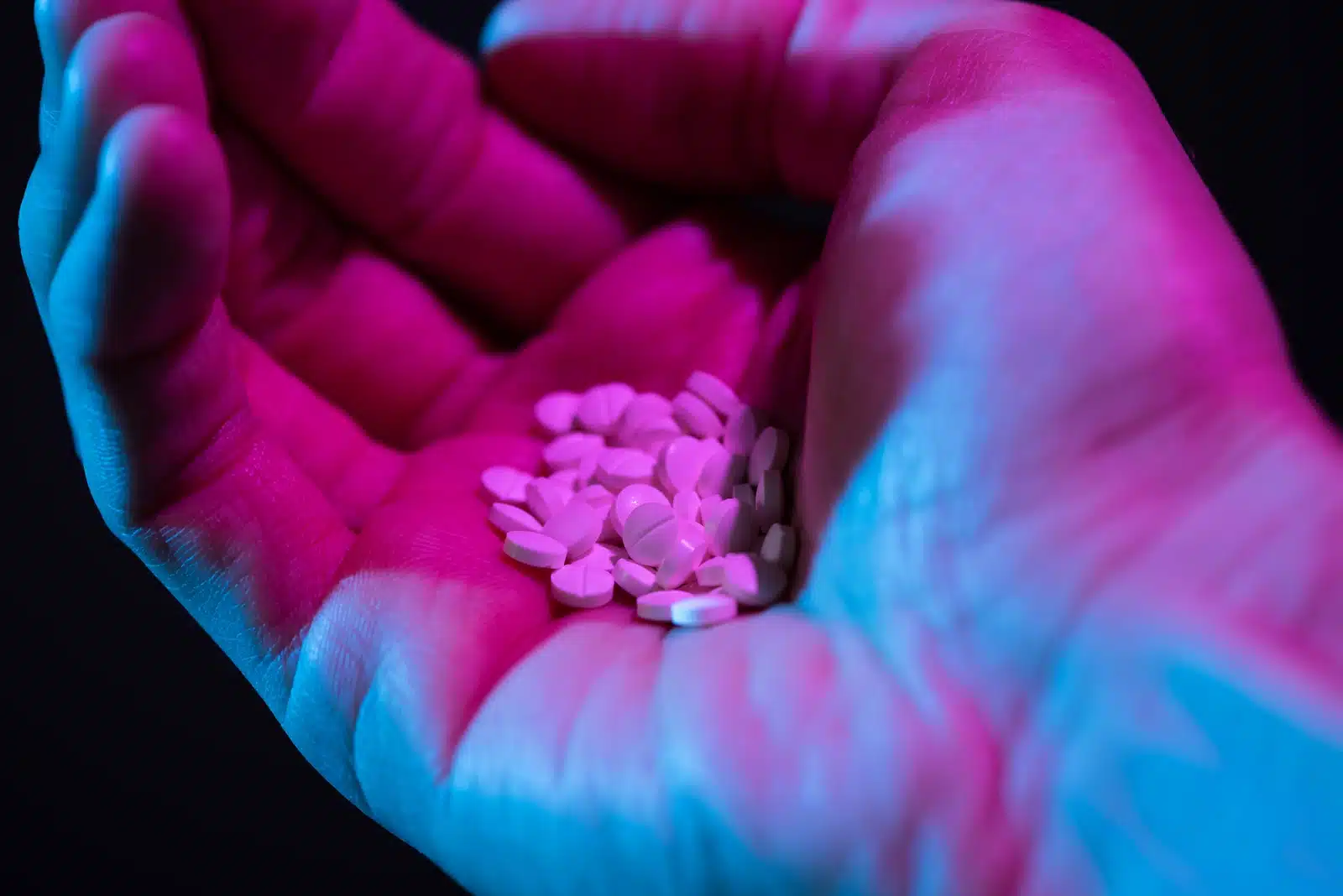Substances
How Long Does Molly Last? Duration of Effects and Treatment Options

Medically Reviewed By
Dr. Po-Chang Hsu, M.D., M.S
On July 21, 2025
Written By
Amanda Stevens, BS
Updated On July 21, 2025
Substances

Medically Reviewed By
Dr. Po-Chang Hsu, M.D., M.S
On July 21, 2025
Written By
Amanda Stevens, BS
Updated On July 21, 2025
Molly is the street name for MDMA (3,4-methylenedioxymethamphetamine). Known for its hallucinogenic and stimulant effects, Molly causes changes in perception, for example, an increased sense of closeness with others and enjoyment in tactile experiences.
So, how long does Molly last? There is an average timeline of approximately 3 hours, but certain factors may influence how long the high from the drug lasts for you.
According to the National Institute on Drug Abuse (NIDA), the effects of Molly usually peak within 15-30 minutes and last for about three hours.[1] This means that desired effects, such as euphoria, increased energy, reduced inhibition, empathy, and a feeling of closeness with others, occur soon after taking the drug.
Molly is a “club drug” commonly found at parties, nightclubs, and raves. However, this does not mean that it is safe to use; adverse consequences can occur alongside the intended effects of the drug.
MDMA works by releasing neurotransmitters in the brain.[2] These include dopamine and serotonin, often referred to as the “feel-good” neurotransmitters. Unfortunately, continuous use of the drug can cause damage to neuronal cells.
Effects like heightened mood and energy will last for as long as your high does. For most people, this will be about three hours. Adverse effects from the drug, however, often last longer.
A comedown refers to the period following MDMA intoxication when mood, energy, and serotonin levels drop. More intense comedowns may reflect neurochemical depletion or polysubstance use but are not necessarily indicative of dependence.[3] This could indicate the need for addiction treatment, specifically if you continue to use the drug.
The duration of Molly’s effects can vary from person to person. Factors affecting drug reactions may include[4]:
Molly, MDMA, or Ecstasy can, at times, be “cut” with other drugs. This means that, even if you take an Ecstasy pill that looks “normal,” for example, the tablet could also contain another drug, putting you at a greater risk of unexpected or negative effects.
The effects of MDMA go beyond the high that people who use the drug typically desire. Here are some of the potential adverse effects associated with MDMA:[6]
Chronic or high-dose MDMA use may contribute to cardiovascular stress, liver enzyme elevation, or renal complications, especially in the context of hyperthermia, dehydration, or adulterants. However, liver or kidney failure is rare and usually linked to extreme cases.[9]
It is possible to overdose on MDMA. Most of the time, this will happen following repeated use or after combining MDMA with other drugs.[10] Since the primary effects of MDMA wear off within 3 to 6 hours, some users may “re-dose” to prolong the high, which increases the risk of adverse effects such as serotonin syndrome, hyperthermia, or cardiovascular stress—not classic overdose as with drugs like opioids.
MDMA is sometimes mixed with other substances to help with the come-down from certain effects–for example, to promote sleep after MDMA use. Or, one might combine something like alcohol, cannabis, LSD, or ketamine with the drug due to social pressures or simply availability.
The signs of Molly toxicity (overdose) are similar to the signs of other types of drug overdose. Signs of MDMA overdose can include:[11]
In some cases, Molly toxicity can be fatal.[12] If you suspect that someone around you is having an overdose due to Molly or any other substance, seek immediate medical attention.
 The best way to avoid serious repercussions from using Molly, such as overdose, is to stop using the drug. Those who struggle to quit on their own may require addiction treatment. Treatment centers may offer several types of programs, including:
The best way to avoid serious repercussions from using Molly, such as overdose, is to stop using the drug. Those who struggle to quit on their own may require addiction treatment. Treatment centers may offer several types of programs, including:
When you first stop using ecstasy/Molly, you may benefit from sub-acute detox or medical detox services. These will help you get through the acute withdrawal stage. MDMA detox does not typically involve life-threatening withdrawal symptoms, unlike alcohol or benzodiazepine withdrawal. Emotional and psychological symptoms may still require professional support.
Inpatient drug rehab for MDMA and other illicit drugs involves living on-site at a treatment center, usually for around 30-60 days. This treatment option offers intensive therapy and ensures that you will have around-the-clock support from healthcare professionals if needed. Since you will live on-site for the duration of the program, inpatient rehab can help individuals with drug use and build new routines during the early stages of recovery.
Once inpatient rehab is completed, clients often transition to an outpatient program for continued care. This is known as a step-down approach, which is often recommended by treatment centers to help ease your transition back into everyday life.
Outpatient substance abuse treatment makes it possible to get help for MDMA abuse while living at home or in sober housing. Sometimes, such as in the case of an intensive outpatient program (IOP), this can involve coming to treatment as little as a few hours per day, about three days per week.
Partial hospitalization programs (PHPs), also called day treatment, provide care more intensive than a typical IOP. PHP generally requires attending a treatment center about five days a week for most of the day, although this can vary depending on the specific facility you attend.
Sometimes, individuals facing Molly abuse live with a co-occurring mental health disorder. For example, a person with depression may use MDMA to help them feel the positive or warm emotions associated with the drug, and a person with an anxiety disorder might use it to feel closer to other people.
When mental disorders co-occur with drug addiction, it’s recommended that individuals get integrated treatment.[13] Also called dual-diagnosis treatment, integrated treatment addresses addiction and co-occurring disorders simultaneously and is offered by many substance abuse treatment facilities.
Usually, there is an underlying cause of drug abuse. Even if you started using Molly as a party drug, it can lead to more serious problems, including dependence. Treatment can help you or your loved one overcome MDMA use and the challenges that may have played a role or increased the risk of developing an MDMA dependence.
Hope and healing are just a phone call away. Don’t take your chances; reach out about treatment for yourself or the person in your life who is using ecstasy today.
Below are some of the most frequently asked questions regarding how long molly lasts
[1] U.S. Department of Health and Human Services. (2024, November 29). MDMA (Ecstasy/Molly). National Institutes of Health. https://nida.nih.gov/research-topics/mdma-ecstasy-Molly
[2] Mustafa, N. S., Bakar, N. H. A., Mohamad, N., Adnan, L. H. M., Fauzi, N. F. A. M., Thoarlim, A., Omar, S. H. S., Hamzah, M. S., Yusoff, Z., Jufri, M., & Ahmad, R. (2020). MDMA and the brain: A short review on the role of neurotransmitters in neurotoxicity. Basic and clinical neuroscience. https://pmc.ncbi.nlm.nih.gov/articles/PMC7878040/
[3] McKetin R;Copeland J;Norberg MM;Bruno R;Hides L;Khawar L; (n.d.). The effect of the ecstasy “come-down” on the diagnosis of ecstasy dependence. Drug and alcohol dependence. https://pubmed.ncbi.nlm.nih.gov/24703083/
[4] Alomar, M. J. (2014, April). Factors affecting the development of Adverse Drug Reactions (review article). Saudi pharmaceutical journal : SPJ : the official publication of the Saudi Pharmaceutical Society. https://pmc.ncbi.nlm.nih.gov/articles/PMC3950535/
[5] Centers for Disease Control and Prevention. (n.d.). Polysubstance use facts. Centers for Disease Control and Prevention. https://www.cdc.gov/stop-overdose/caring/polysubstance-use.html
[6] Ecstasy or MDMA (also known as Molly). DEA. (n.d.). https://www.dea.gov/factsheets/ecstasy-or-mdma-also-known-Molly
[7] Dunlap, L. E., Andrews, A. M., & Olson, D. E. (2018, October 17). Dark classics in chemical neuroscience: 3,4-methylenedioxymethamphetamine. ACS chemical neuroscience. https://pmc.ncbi.nlm.nih.gov/articles/PMC6197894/
[8] RJM;, C. (n.d.). MDMA-associated liver toxicity: Pathophysiology, management, and current state of knowledge. AACN advanced critical care. https://pubmed.ncbi.nlm.nih.gov/31462520/
[9] Bora, F., Yılmaz, F., & Bora, T. (2016, November). Ecstasy (MDMA) and its effects on kidneys and their treatment: A Review. Iranian journal of basic medical sciences. https://pmc.ncbi.nlm.nih.gov/articles/PMC5126214/
[10] In-Hei Hahn, M. (2025, March 28). MDMA toxicity clinical presentation. History, Physical Examination. https://emedicine.medscape.com/article/821572-clinical
[11] Figurasin, R., Lee, V. R., & Maguire, N. J. (2024, January 17). 3,4-Methylenedioxymethamphetamine (MDMA) toxicity. StatPearls – NCBI Bookshelf. https://www.ncbi.nlm.nih.gov/books/NBK538482/
[12] U.S. National Library of Medicine. (2001, September). A fatal case of ecstasy poisoning. Paediatrics & child health. https://pmc.ncbi.nlm.nih.gov/articles/PMC2807764/
[13] Managing life with co-occurring disorders. SAMHSA. (n.d.). https://www.samhsa.gov/mental-health/serious-mental-illness/co-occurring-disorders
[14] Drug fact sheet: Ectasy/MDMA. (n.d.-a). https://www.dea.gov/sites/default/files/2020-06/Ecstasy-MDMA-2020_0.pdf